
A PHASE 3 STUDY THAT ASSESSED DISEASE PROGRESSION IN EARLY SYMPTOMATIC ALZHEIMER’S DISEASE (AD) BY REDUCING AMYLOID PLAQUES1,2
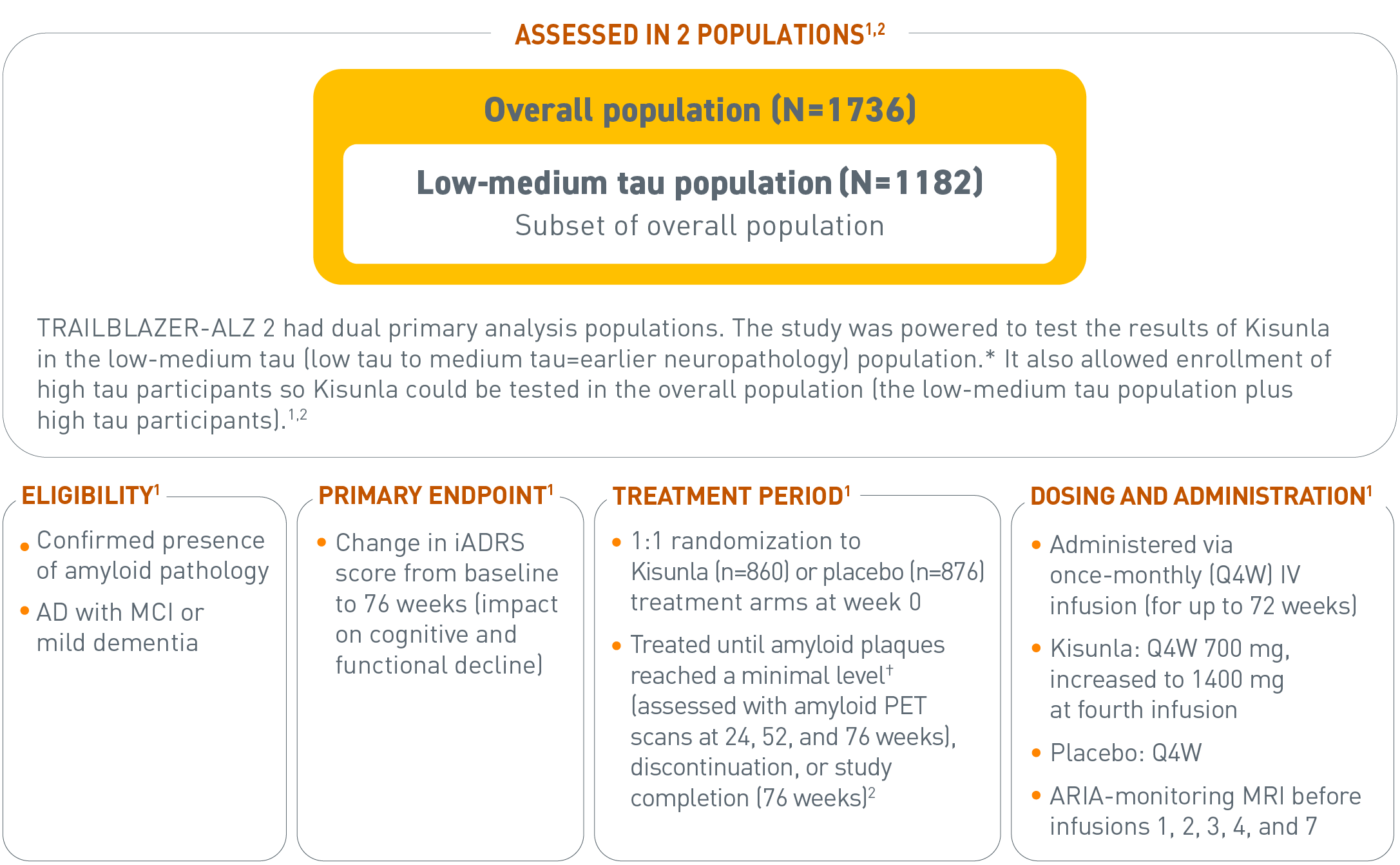
Overall population (N=1736). Low-medium tau population (N=1182). Subset of overall population.1,2 Kisunla was assessed in patients who had MCI or mild dementia due to Alzheimer’s disease (AD) and who were amyloid positive. The study was powered to test the results of Kisunla in the low-medium tau populationa (N=1182) and allowed enrollment of participants with high tau levels so Kisunla could also be tested in the overall population (low-medium tau plus high tau levels) (N=1736). Participants were included in the study if they had confirmed presence of amyloid pathology and MCI or mild dementia. The primary efficacy endpoint was iADRS score (impact on cognitive and functional decline). Patients were randomized 1:1 to receive either Kisunla (n=860) 700 mg via once-monthly (Q4W) IV infusion (for up to 72 weeks), increased to 1400 mg at the fourth infusion, or placebo (n=876) treatment arms at week 0. Patients were treated until stopping criteria reachedb (assessed with amyloid PET scans at 24, 52, and 76 weeks), discontinuation, or study completion (76 weeks). ARIA-monitoring MRI was performed before infusions 1, 2, 3, 4, and 7.1,2
*There were 2 primary analysis populations based on tau PET imaging with flortaucipir: 1) low-medium tau level population (SUVR of ≥1.10 and ≤1.46), and 2) combined population of low-medium plus high tau (SUVR >1.46).1
†In the protocol, if the amyloid plaque level was <11 Centiloids on a single PET scan or 11 to <25 Centiloids on 2 consecutive PET scans, the patient was eligible to be switched to placebo.2
For reference, <24.1 Centiloids on an amyloid PET scan is consistent with a negative visual read.3
ARIA=amyloid-related imaging abnormalities; iADRS=integrated Alzheimer’s Disease Rating Scale; IV=intravenous; MCI=mild cognitive impairment; MRI=magnetic resonance imaging; PET=positron emission tomography; Q4W=every 4 weeks; SUVR=standardized uptake value ratio.
THE POWER OF KISUNLA WAS MEASURED ON A VALIDATED, INTEGRATED SCALE OF COGNITION AND FUNCTION2
iADRS: An integrated assessment of cognition and daily function2*
iADRS MEASURES AD SEVERITY AND REFLECTS THE IMPACT OF COGNITIVE LOSS ON THE ABILITY TO COMPLETE DAILY TASKS2,4,5

iADRS measures global Alzheimer’s disease (AD) severity and reflects the impact of cognitive loss on the ability to complete daily tasks. Elements of cognitive ability are measured using the ADAS-Cog13, while elements of function are measured using the ADCS-iADL. Cognitive ability elements include memory, language, orientation, attention, and planning and execution of movements. Functional ability elements include clearing the dishes, disposing of garbage, making meals, obtaining beverages, using household appliances, writing, reading, keeping appointments, shopping, getting around, finding belongings, selecting clothes, engaging in hobbies, having conversations, using the telephone, talking about current events, watching television, and being left alone.2,4,5
*The primary efficacy endpoint was change in the iADRS score from baseline to 76 weeks (18 months). The iADRS is a combination of 2 scores: the ADAS-Cog13 and the ADCS-iADL. The total score ranges from 0 to 144, with lower scores reflecting worsening cognitive and functional performance.2
ADAS-Cog13=Alzheimer’s Disease Assessment Scale-Cognitive Subscale; ADCS-iADL=Alzheimer’s Disease Cooperative Study—instrumental Activities of Daily Living; iADRS=integrated Alzheimer’s Disease Rating Scale.
“The biggest fear anyone has of developing Alzheimer’s disease is losing their cognitive and functional abilities and becoming more reliant on others. When I talk to patients about amyloid-targeting treatments, they are encouraged by the results showing slowing in disease progression.”
Dr Rosemary Laird, MD, MHSA, AGSF
Founder and Chief Medical Officer, My Memory Clinic, LLC
Dr Laird was compensated for her commentary.

KISUNLA GIVES YOU THE POWER TO HELP SLOW COGNITIVE AND FUNCTIONAL DECLINE IN PATIENTS WITH EARLY SYMPTOMATIC AD1,2,6
iADRS Change From Baseline Through 76 Weeks1,2,6
LOW-MEDIUM TAU
POPULATION1,2,6,a,b
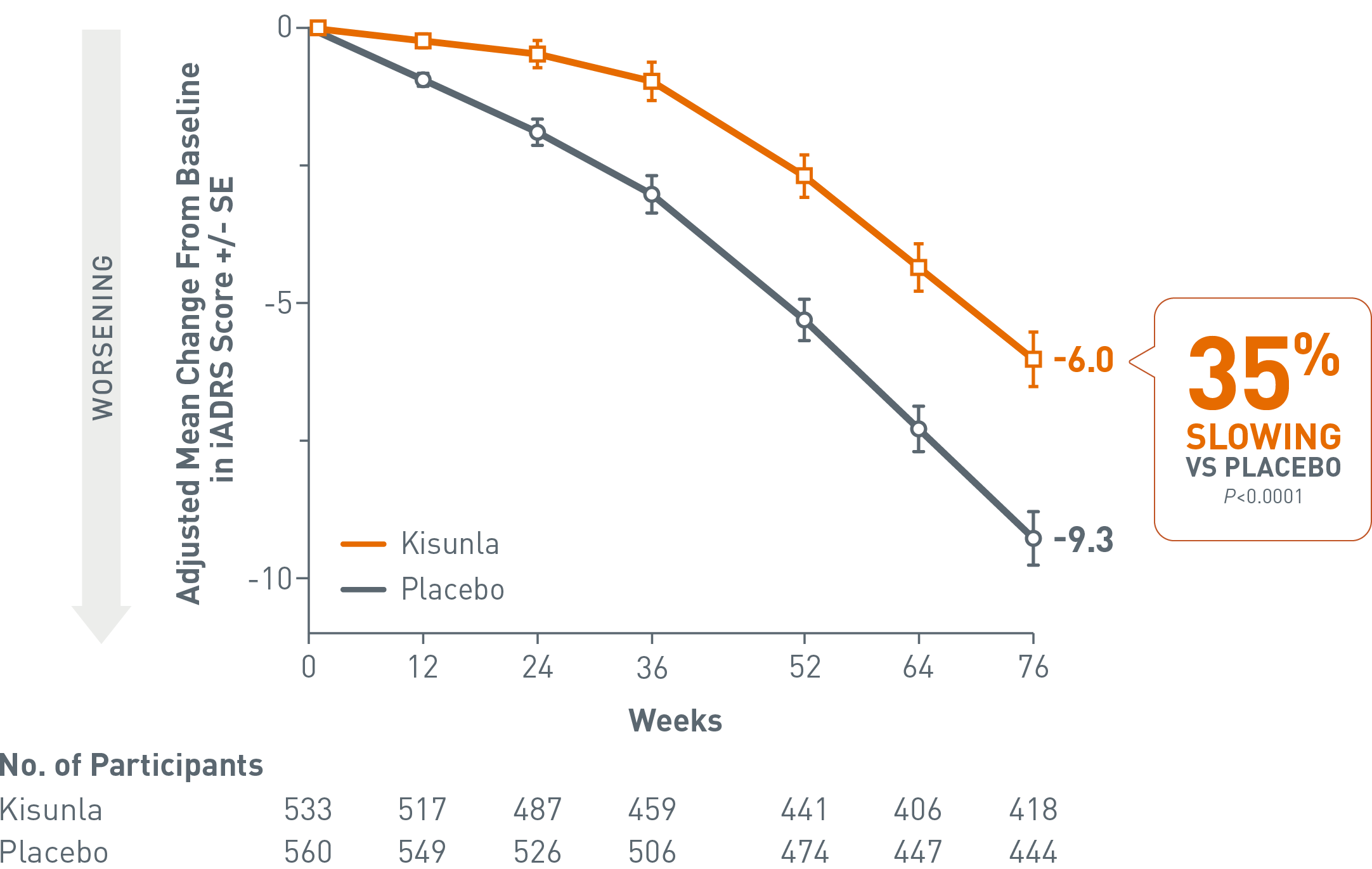
aAssessed using NCS2 analysis.2
bMean baseline Kisunla: 105.92; mean baseline placebo: 105.95.2
Participants treated with Kisunla in the low-medium tau population had statistically significantly less decline in cognition/function than patients treated with placebo as assessed by the iADRS at week 76 (Kisunla: n=418; placebo: n=444). At week 76, adjusted mean change from baseline for patients treated with Kisunla was -6.0 vs -9.3 for placebo. The adjusted mean change difference from placebo was 3.3 (35%); P<0.0001.1,2,6
OVERALL
POPULATION1,2,6,a,b
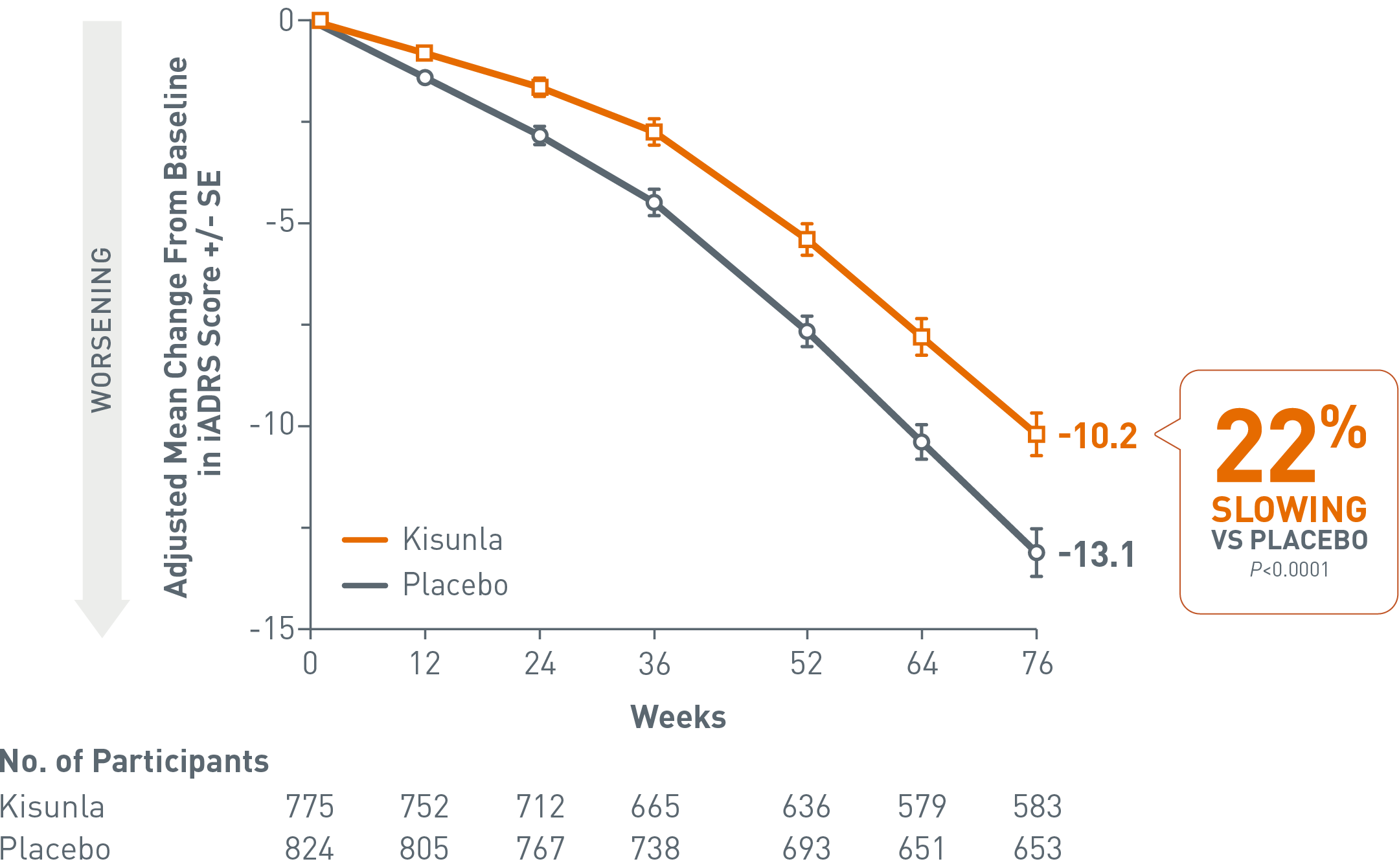
aAssessed using NCS2 analysis.2
bMean baseline Kisunla: 104.55; mean baseline placebo: 103.82.2
Participants treated with Kisunla in the overall population had statistically significantly less decline in cognition/function than patients treated with placebo as assessed by the iADRS at week 76 (Kisunla: n=583; placebo: n=653). At week 76, adjusted mean change from baseline for patients treated with Kisunla was -10.2 vs -13.1 for placebo. The adjusted mean change difference from placebo was 2.9 (22%); P<0.0001.1,2,6
iADRS scores range from 0 to 144 with lower scores indicating greater impairment.1
iADRS=integrated Alzheimer’s Disease Rating Scale; LS=least squares; NCS2=natural cubic spline with 2 degrees of freedom; SE=standard error.
“After 25 years caring for individuals with cognitive impairment, I’m able to tell those in the early symptomatic stages of Alzheimer”s disease that we can slow down the disease progression with amyloid-targeting therapies.”
Dr Andrew Budson, MD
Boston University
Dr Budson was compensated for his commentary.

HELP KEEP YOUR PATIENTS IN THE EARLIER STAGES OF DISEASE LONGER2

In the overall population, 37% reduced risk of progressing to the next stage of disease vs placebo through 76 weeks; P<0.001.2
CDR-GS: Time to worsening of disease
- HR: Overall population=0.63†; 95% CI: 0.51, 0.77; low-medium tau=0.61†; 95% CI: 0.47, 0.802
- In the low-medium tau population, a 39% reduced risk vs placebo was observed through 76 weeks (N=1182); P<0.0012
*Progression to next clinical stage was defined as any increase in CDR-GS at 2 consecutive visits from baseline. 0=normal; 0.5=very mild dementia; 1=mild dementia; 2=moderate dementia; 3=severe dementia.2
†The HR is the relative risk reduction for substantial decline achieved by Kisunla vs placebo.2
CDR-GS=Clinical Dementia Rating Scale-Global Score; CI=confidence interval; HR=hazard ratio.
“Because we can now slow down the disease progression, it’s critical to diagnose and start treatment at the first symptoms of Alzheimer’s. Starting early can help keep patients in the early stages of disease longer.”
Dr Andrew Budson, MD
Boston University
Dr Budson was compensated for his commentary.

SELECT IMPORTANT SAFETY INFORMATION
WARNING: AMYLOID-RELATED IMAGING ABNORMALITIES
Monoclonal antibodies directed against aggregated forms of beta amyloid, including Kisunla, can cause amyloid-related imaging abnormalities (ARIA), characterized as ARIA with edema (ARIA-E) and ARIA with hemosiderin deposition (ARIA-H). ARIA usually occurs early in treatment and is usually asymptomatic, although serious and life-threatening events rarely can occur. Serious intracerebral hemorrhages >1 cm, some of which have been fatal, have been observed in patients treated with this class of medications. Because ARIA-E can cause focal neurologic deficits that can mimic an ischemic stroke, treating clinicians should consider whether such symptoms could be due to ARIA-E before giving thrombolytic therapy in a patient being treated with Kisunla.
ApoE ε4 Homozygotes: Patients who are apolipoprotein E ε4 (ApoE ε4) homozygotes treated with this class of medications, including Kisunla, have a higher incidence of ARIA, including symptomatic, serious, and severe radiographic ARIA, compared to heterozygotes and noncarriers. Testing for ApoE ε4 status should be performed prior to initiation of treatment to inform the risk of developing ARIA. Prior to testing, prescribers should discuss with patients the risk of ARIA across genotypes and the implications of genetic testing results.
Consider the benefit for the treatment of Alzheimer's disease and risk of ARIA when deciding to treat with Kisunla.
SLOWING OF DECLINE WAS DEMONSTRATED ACROSS ALL SECONDARY CLINICAL ENDPOINTS1
RESULTS FOR KEY SECONDARY ENDPOINTS AT 76 WEEKS1,2,5,7
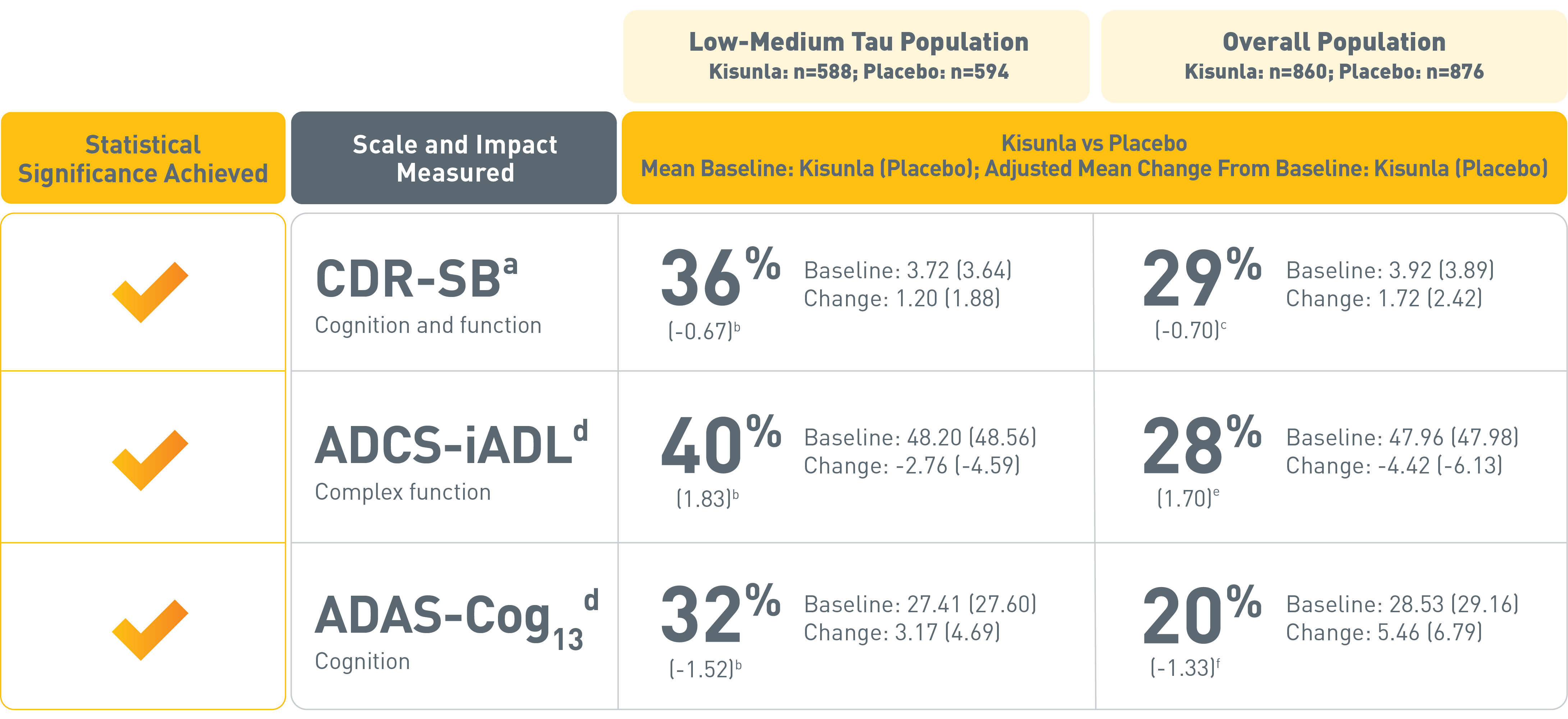
In the low-medium tau population (Kisunla: n=588 and placebo: n=594), statistical significance was achieved across 3 key secondary endpoints at 76 weeks. In the overall population (Kisunla: n=860 and placebo: n=876), statistical significance was also achieved across these 3 key secondary clinical endpoints at 76 weeks. The 3 scales were: CDR-SB, which measures cognition and function; ADCS-iADL, which measures complex function; and ADAS-Cog13, which measures cognition.1,2,5,7
In the low-medium tau population2,7:
-
Kisunla slowed decline by 36% (-0.67)b vs placebo for CDR-SBa
- Mean baseline: 3.72 for Kisunla and 3.64 for placebo
- Change from baseline: 1.20 for Kisunla and 1.88 for placebo
-
Kisunla slowed decline by 40% (1.83)b vs placebo on ADCS-iADLd
- Mean baseline: 48.20 for Kisunla and 48.56 for placebo
- Change from baseline: -2.76 for Kisunla and -4.59 for placebo
-
Kisunla slowed decline by 32% (-1.52)b vs placebo on ADAS-Cog13d
- Mean baseline: 27.41 for Kisunla and 27.60 for placebo
- Change from baseline: 3.17 for Kisunla and 4.69 for placebo
In the overall population1:
-
Kisunla slowed decline by 29% (-0.70)c vs placebo on CDR-SBa
- Mean baseline: 3.92 for Kisunla and 3.89 for placebo
- Change from baseline: 1.72 for Kisunla and 2.42 for placebo
-
Kisunla slowed decline by 28% (1.70)e vs placebo on ADCS-iADLd
- Mean baseline: 47.96 for Kisunla and 47.98 for placebo
- Change from baseline: -4.42 for Kisunla and -6.13 for placebo
-
Kisunla slowed decline by 20% (-1.33)f vs placebo on ADAS-Cog13d
- Mean baseline: 28.53 for Kisunla and 29.16 for placebo
- Change from baseline: 5.46 for Kisunla and 6.79 for placebo
aAssessed using MMRM analysis.1
bP<0.001 vs placebo.2
cP<0.0001 vs placebo.1
dAssessed using NCS2 analysis.1
eP=0.0001 vs placebo.1
fP=0.0006 vs placebo.1
ADAS-Cog13=Alzheimer’s Disease Assessment Scale—13-item Cognitive Subscale; ADCS-iADL=Alzheimer’s Disease Cooperative Study-instrumental Activities of Daily Living; CDR-SB=Clinical Dementia Rating Scale-Sum of Boxes; MMRM=mixed model for repeated measures; NCS2=natural cubic spline with 2 degrees of freedom.
SELECT IMPORTANT SAFETY INFORMATION
Hypersensitivity: Kisunla is contraindicated in patients with known serious hypersensitivity to donanemab-azbt or to any of the excipients. Reactions have included anaphylaxis.
KISUNLA DEMONSTRATED REDUCTION IN AMYLOID PLAQUES AS EARLY AS 6 MONTHS1,8
Amyloid Plaque Reduction From Baseline in the Overall Population in TRAILBLAZER-ALZ 21,8

Patients treated with placebo had an average of <1% amyloid plaque reduction from baseline to 18 months.1,8
Mean baseline (n=712) amyloid plaque level for patients treated with Kisunla was 103.7 Centiloids (placebo was 101.4 Centiloids). The mean change from baseline was -62.8 Centiloids at 6 months (n=702), -82.8 Centiloids at 12 months (n=627), and -86.9 Centiloids at 18 months (n=571).1,8
NEARLY HALF OF PATIENTS WERE ABLE TO STOP TREATMENT* BY 1 YEAR1
PERCENTAGE OF PATIENTS IN THE OVERALL POPULATION ACHIEVING STOPPING CRITERIA* AT KEY TIME POINTS1,9†
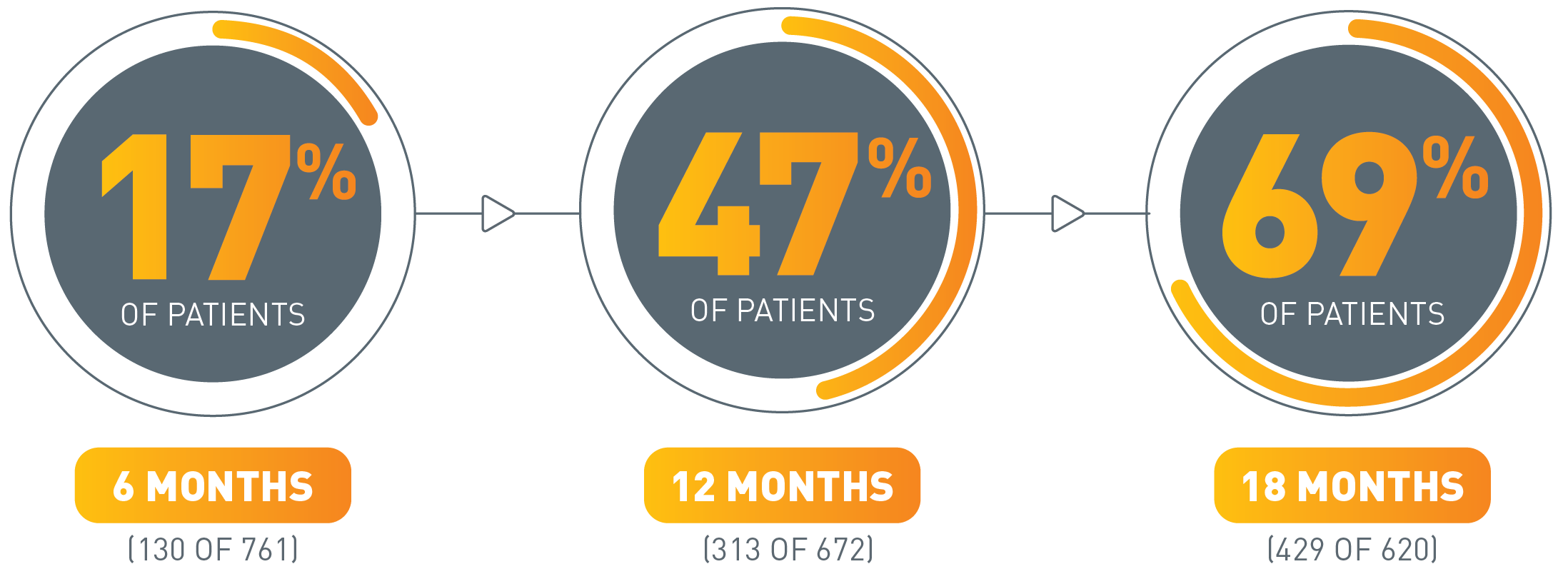
In patients treated with Kisunla: 17% (130/761) achieved stopping criteria at 6 months, 47% (313/672) at 12 months, and 69% (429/620) at 18 months.1,9
Kisunla was stopped based on removal of amyloid plaques to minimal levels on amyloid PET imaging in TRAILBLAZER-ALZ 2.1
*In the protocol, if the amyloid plaque level was <11 Centiloids on a single PET scan or 11 to <25 Centiloids on 2 consecutive PET scans, the patient was eligible to be switched to placebo. Amyloid PET values may increase after treatment with Kisunla is stopped. There are no data beyond the 76-week duration of the clinical trial to guide whether additional dosing with Kisunla may be needed for longer-term clinical benefit.1
For reference, <24.1 Centiloids on an amyloid PET scan is consistent with a negative visual read.3
†The mean baseline amyloid levels for patients treated with Kisunla were 103.5 Centiloids for the overall population, and 102.4 Centiloids for the low-medium tau population.2
PET=positron emission tomography.
References:
- Kisunla (donanemab-azbt). Prescribing Information. Lilly USA, LLC.
- Sims JR, Zimmer JA, Evans CD, et al; for TRAILBLAZER-ALZ 2 Investigators. Donanemab in early symptomatic Alzheimer disease: the TRAILBLAZER-ALZ 2 randomized clinical trial. JAMA. 2023;330(6):512-527.
- Navitsky M, Joshi AD, Kennedy I, et al. Standardization of amyloid quantitation with florbetapir standardized uptake value ratios to the Centiloid scale. Alzheimers Dement. 2018;14(12):1565-1571.
- Wessels AM, Rentz DM, Case M, et al. Integrated Alzheimer’s Disease Rating Scale: clinically meaningful change estimates. Alzheimers Dement (N Y). 2022;8:e12312. doi:10.1002/trc2.12312
- Wessels AM, Dennehy EB, Dowsett SA, et al. Meaningful clinical changes in Alzheimer disease measured with the iADRS and illustrated using the donanemab TRAILBLAZER-ALZ study findings. Neurol Clin Pract. 2023;13(2):e200127. doi:10.1212/CPJ.0000000000200127
- Data on File. Lilly USA, LLC. DOF-DN-US-0053.
- Data on File. Lilly USA, LLC. DOF-DN-US-0054.
- Data on File. Lilly USA, LLC. DOF-DN-US-0029.
- Data on File. Lilly USA, LLC. DOF-DN-US-0049.